There’s no such thing as breathable waders when you’re hiking in them in July. Wading boots aren’t for hiking either, but I’m making due. I have a camera pack on my back and it’s heavy enough without extra clothes and shoes tacked on. As I said, I’m making due, but I don’t recommend it.
I hiked this wooded trail in shorts and running shoes with my boys yesterday. It follows Palisades Creek in eastern Idaho. We spied spawners jumping the falls on our adventure and I knew I’d be back. That’s where I’m heading today with my cameras instead of my kids.
It’s noon when I reach the waterfall. I scramble to the top of a mid-river boulder and wait, my eyes fixed on four feet of cascading water. The stakeout runs 10 minutes before fin appears. A Yellowstone cutthroat trout springs out of the water against the current, flips for all it’s worth to clear the falls, doesn’t have enough air and drops back into the creek. I quietly jump around in my sweaty waders and start getting my cameras out. The fish are still spawning. Figured they would be since I only saw them 24 hours ago, but I had to be sure. Now I’m sure and it’s time to roll on the river jumpers.
“It is really amazing what fish can do when they are trying to go spawn,” says Brett High, Idaho Department of Fish and Game fisheries biologist. “We’ve seen fish hold their positions almost vertically in a waterall for several seconds. When they put their mind to it, they can go through some pretty incredible obstacles.”
I’m camped at one of those obstacles. It’s peak season for fish porn and I’m catching an eyeful of it. I keep my lens pointed at the waterfall for an hour. A fish makes a jump for it about every three-eight minutes. When I have plenty of that from above, I put the dry camera away and get out the underwater revealer.
I started shooting underwater footage in 2011 and I learned perfection the hard way with a lot of losses. That’s why my underwater camera is attached to something at all times. This time it’s attached to a trekking pole so I can stay on the boulder and drop the lens under the pounding precip. without losing it. I have yet to wet my waders and that’s intentional. It’s tip number one.
Stay out
Underwater doesn’t mean you need to be in the water. This is especially important if there’s someone else in the water, say a snorkeling biologist counting spawners. He needs to see what’s swimming. If you get in the river and tromp around in wading boots, not only does he lose visibility, your lens loses visibility too. And the fish will certainly leave with you knocking around in the honey hole.
Let it lie
Leave your camera alone to do its thing without you holding it. I’m not a strong swimmer so I rarely fully submerge. Besides, my camera is less intrusive than I am so often times I anchor the lens with a rock and leave it to collect what passes underneath while I work the banks above with a camera that will tank if a single drop of water washes over it. It’s a shooter pulling double duty solo, but I like the ruckus of the challenge.
Patrol placement
Let your camera lie, but don’t wander too far from it. Make sure it has solid hold so the current doesn’t carry it away. You don’t want to lose the camera, or the footage on it. Fish like to hold where the swim is easy the buffet floats right by their mouths. That’s also calm water for camera mounting, but be sure not to leave any sticky mounts or other gear garbage when you wrap up.
Wear a lanyard
I dunked a camera in the Green River and watched it roll along the bottom. I came close to puking. It was waterproof, but it was way out of my hands and at risk of loss. That little episode inspired my mocking husband to make me the girliest bright pink lanyard with an extension cord that attaches to my underwater camera. I have plenty of reach with it and I won’t lose my load when the camera slips out of my hands because it’s attached at my neck.
Hold still
Some shooters like to let underwater cameras float with the current. That can work, but not for every shot. Causes motion sickness for viewers so stop the movement. Stick your trekking pole in the river bottom or trap the camera between rocks. The water can move passed your lens, but the lens always bobbing along with the flow isn’t fun to watch.
Be shallow
I once shot underwater footage on Colorado’s Arkansas River when it was running well under 100 cubic feet per second (CFS). It was so shallow, my boots were barely in it. It’s some of the prettiest underwater footage I have. The rocks on the river bottom are prominent, the water is gin clear and there’s plenty of light in the dark, but not glaring sunlight busting the shot as it does when the lens comes completely out of the water. Plus, in shallow water, you can always crawl after your camera if you ignore the lanyard tip and your camera gets away.
Of course it’s shallow where I’m shooting around the waterfall on the creek. I’ve chosen well. It’s small water with big trout. I see pairs weaving in the shade prepping for a push into the sunny, swift channel for another jump attempt. They want their offspring planted safely above the crushing rush. They’ll keep jumping for posterity until they clear the hurdle and I’ll keep shooting fish porn while they go for it.




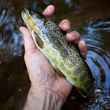
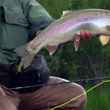











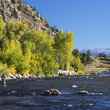




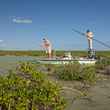




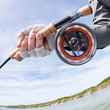




Comments
Vivek Krishnan replied on Permalink
Great photography, keep up the good sprit and don't leave your passion!
Pages